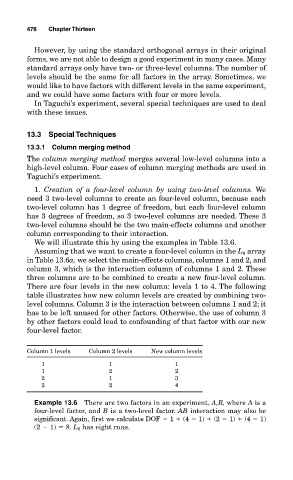Page 517 - Design for Six Sigma a Roadmap for Product Development
P. 517
476 Chapter Thirteen
However, by using the standard orthogonal arrays in their original
forms, we are not able to design a good experiment in many cases. Many
standard arrays only have two- or three-level columns. The number of
levels should be the same for all factors in the array. Sometimes, we
would like to have factors with different levels in the same experiment,
and we could have some factors with four or more levels.
In Taguchi’s experiment, several special techniques are used to deal
with these issues.
13.3 Special Techniques
13.3.1 Column merging method
The column merging method merges several low-level columns into a
high-level column. Four cases of column merging methods are used in
Taguchi’s experiment.
1. Creation of a four-level column by using two-level columns. We
need 3 two-level columns to create an four-level column, because each
two-level column has 1 degree of freedom, but each four-level column
has 3 degrees of freedom, so 3 two-level columns are needed. These 3
two-level columns should be the two main-effects columns and another
column corresponding to their interaction.
We will illustrate this by using the examples in Table 13.6.
Assuming that we want to create a four-level column in the L 8 array
in Table 13.6a, we select the main-effects columns, columns 1 and 2, and
column 3, which is the interaction column of columns 1 and 2. These
three columns are to be combined to create a new four-level column.
There are four levels in the new column: levels 1 to 4. The following
table illustrates how new column levels are created by combining two-
level columns. Column 3 is the interaction between columns 1 and 2; it
has to be left unused for other factors. Otherwise, the use of column 3
by other factors could lead to confounding of that factor with our new
four-level factor.
Column 1 levels Column 2 levels New column levels
1 1 1
1 2 2
2 1 3
2 2 4
Example 13.6 There are two factors in an experiment, A,B, where A is a
four-level factor, and B is a two-level factor. AB interaction may also be
significant. Again, first we calculate DOF 1 (4 1) (2 1) (4 1)
(2 1) 8. L 8 has eight runs.

